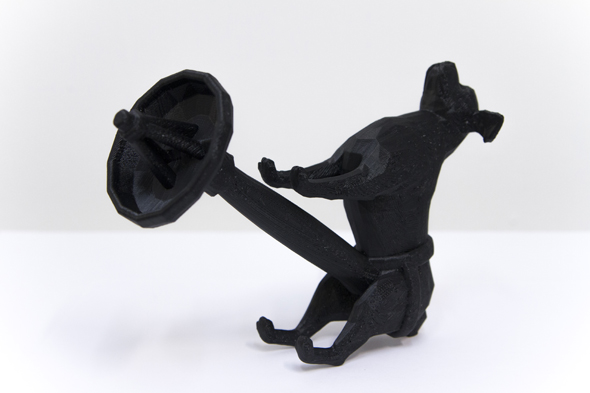Last week I had the pleasure of travelling to Chicago to represent TAG at the College Art Association’s annual conference, a sprawling affair comprising tens of simultaneous panels and events distributed across the huge and sterile cod-Napoleonic ballrooms of the Hilton, each home to a particular subsubspecies of art historian specializing in, say, the manufacture of pigments in Early Modern Flanders or what Robert Smithson was reading (he turns out, intriguingly enough, to have been a voracious sci-fi fan).
Our panel apart, direct references to games were thin on the ground at the conference proper, though I missed a panel on the gamification of art pedagogy (which is apparently to be encouraged, from the drift of the abstracts) while catching a number of other talks with tangential but suggestive links to videogame culture. A presentation on Victorian stereoscope viewers demonstrated that a century and a half before the Oculus Rift there was already a sizable market for clunky-looking eyewear that let users explore virtual 3D spaces, while the University of Toronto’s Matthew Allen posed some intriguing questions in a paper on the pioneering CAD system Sketchpad and the birth of the screenshot. Other highlights included a roundtable on 3D printing and a brilliant talk on glitch by Daniel Temkin, who reminded us that what we see as error has more to do, in most cases, with imperfect understanding on the part of the user/viewer than it does technological faults or flaws.
We – which is to say myself and my co-panelists Zara Dinen, Daniel Rourke and Alex Myers – had been invited to give a panel for the CAA’s New Media Caucus, and our papers all used the concept of exaptation as a framework for thinking the cultural history of digital media. Coined by evolutionary biologists Stephen Jay Gould and Elisabeth Vrba, the term exaptation refers to instances where a trait which initially evolved in response to one set of conditions is ‘co-opted’ to serve another purpose – the classic example being feathers, which biologists postulate may have originally caught on as a means of regulating body temperature and staging mating dances, but which eventually became capable of facilitating flight. The term has itself been exapted by art historians (and indeed game designers) interested in imagining alternate histories and in challenging notions of intentionality and progress by attending to contingencies, lateral moves, apparent anachronisms and the agency of non-human actors.
Each of us approached the question in a different way. Zara discussed the role of holograms in the cultural imaginary while Daniel proposed that the various representations of the Superman universe’s ‘Phantom Zone’ constitute a kind of vernacular media archaeology (Superman 64 didn’t come up, for better or worse). Alex and I, meanwhile, focused on games. My paper challenged the narrativisation of the PlayStation brand in terms of a progressive ‘evolution’, looking at how the PS2’s backwards compatibility (which resulted from the felicitous discovery that the PS1’s CPU could be repurposed as the PS2’s I/O chip) helped it win that generation’s console war – a trick that, as we now know, has proven difficult to repeat. Alex, an artist who teaches game design and makes things like the savagely satirical Counterstrike mod Winning, used his paper to contest Indiecade grandee John Sharp’s claim, outlined in his essay A Curiously Short History of Game Art, that game art died in 2006. Reviewing some of the form’s greatest hits – from Ars Doom to Tom Bett’s QQQ – Alex argued that more recent works like Dust to Dust, We Make the Weather and Eddo Stern’s forthcoming Darkgame are at least as inventive, demonstrating the ingenuity and productivity of a game art community undaunted by the reticence of galleries and collectors.
Speaking of prolific arts communities, CAA also provided an alibi for checking out Chicago’s new media arts scene – which, going by the shows we saw and the artists and curators we met, is in enviably rude health. James Connolly and Kyle Evans’ Cracked Ray Tube performance offered an alternately grueling and pretty dose of CRT abuse, while Tritriangle gallery’s Stuff on Stuff on Stuff, a bring-your-own-laptop event masterminded by Jennifer Chan, was replete with games, videos, gifs and music machines. Particularly memorable were Morehshin Allahyari’s digital sculptures, unholy hybrids (a Barbie with a VHS for a thorax, a dog-dildo-satellite dish) whose components share the distinction of being officially banned in Iran.
Final words must go to the city of Chicago’s dogged commitment to keeping arcade machines around. From bars and cafes to launderettes and cineplexes, I can’t remember the last time I saw so many cabinets in the wild – and, as every good art historian knows, there’s no better way to decompress after an intense roundtable on the post-medium condition than a quick tilt at a late ‘90s Psikyo shmup.
Rob Gallagher

